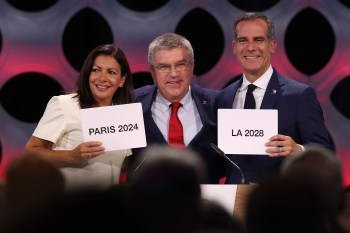
The multibillion-dollar youth sports industry is leaving lots of kids on the sidelines
The multibillion-dollar youth sports industry is leaving lots of kids on the sidelines

From private coaches to travel league fees, there’s a lot of money caught up in the world of youth sports. In her book, “Take Back the Game: How Money and Mania Are Ruining Kids’ Sports — and Why It Matters,” journalist Linda Flanagan explores what she describes as the “ecosystem” of the kids’ sports industry: the private leagues, the hotels for tournaments and the college athletic departments looking to recruit young athletes. A 2019 analysis from WinterGreen Research estimated the youth sports industry was worth $19.2 billion; that same year, the NFL was worth an estimated $15 billion.
Flanagan spoke to “Marketplace” host Kai Ryssdal about how size of the industry is leading to lots of kids who are able to participate, and plenty who aren’t. The following is an edited transcript of their conversation.
Kai Ryssdal: That money is coming from parents, I guess, who want their kids to play all these sports?
Linda Flanagan: Yes, It goes into travel, to equipment, to team memberships. There’s an entire world out there that is offering sports options to parents, and they’re paying up. In fact, parents pay reportedly $30 billion a year for their kids’ sports.
Ryssdal: This is, it seems to me, literally a recipe for haves and have-nots, because if you’re some upper-middle-income family, you can afford it. And look, my kids played baseball, and there were, like, $250 baseball bats, which, for the record, I did not buy for my kids —
Flanagan: They’ve gone up.
Ryssdal: Yeah. And they’ve gone up, right? So not every parent can afford that. And so you have kids who simply can’t participate in the bulk of sports today, right?
Flanagan: Well, that’s exactly right. And that’s one of the biggest social problems related to the commercialization of kids’ sports, because now sports are basically class-based. The higher class you are, the more you participate; the lower income you are, the less likely you are to play.
Ryssdal: So let’s talk about the third leg of the ecosystem here: colleges. You point out in this book that the college admissions process incentivizes parents to get their kids playing, whatever the sport is, from an incredibly young age to boost their odds of getting into college 15 years later. And the whole thing seems, frankly, out of whack. But how does that work?
Flanagan: Well, you know, I don’t think the colleges would put it that way, that they incentivize parents to do this, but that’s kind of the result of it. Because there are notable admissions advantages in terms of having lower SAT scores being required. There’s also a streamlined process to get in. Most athletes are recruited and admitted early, so they forgo the, you know, the drama of senior year in high school. If you’re anxious about your child’s chances of getting into a good school, it may seem like a wise way to get them in.
Ryssdal: So let’s do a little bona fides here for you, because you write this book as a mother of athletes, but more importantly, a just-recently retired cross country coach for high school kids. Did you see this? What was your experience on the ground?
Flanagan: Well, this was what was so discouraging to me is that I saw that the purpose of sports for many kids seem to be not about “What you can learn in my sport” from running and training and being with young people your age, but it became about “What can this do for my resume? What can this do for my college prospects?” And also that just the great amount of pressure on young people — they feel such, such pressure to perform.
Ryssdal: So the last thing I want to ask you, since you spend a lot of time on solutions in this book, I want to ask you what the answer is. Because for all that kids do get out of sport — and let’s be upfront about this, right? Because they can be really rewarding, they can be motivating, they can teach discipline and camaraderie and all of those things —
Flanagan: Yes.
Ryssdal: — but it is systemically dysfunctional.
Flanagan: Yes.
Ryssdal: Well, my question to you is, a number of days ago, the Big Ten Conference signed an $8 billion television deal. So how do you we, in the face of that kind of unbelievable money, fix the feeder system?
Flanagan: Well, that’s the question we’d all like the answer to, isn’t it? And I think that it has to be incumbent on parents to realize that they have agency, and perhaps in a perfect world, to organize and try to resist some of this together. Maybe, you know, some of the young people who went through this process, they might start resisting this as well. And who knows what the tipping point is going to be, but I think it has to start in individual homes, and perhaps parents can organize and join leagues and teams and be on those boards to shape the conduct of those organizations.
There’s a lot happening in the world. Through it all, Marketplace is here for you.
You rely on Marketplace to break down the world’s events and tell you how it affects you in a fact-based, approachable way. We rely on your financial support to keep making that possible.
Your donation today powers the independent journalism that you rely on. For just $5/month, you can help sustain Marketplace so we can keep reporting on the things that matter to you.


















